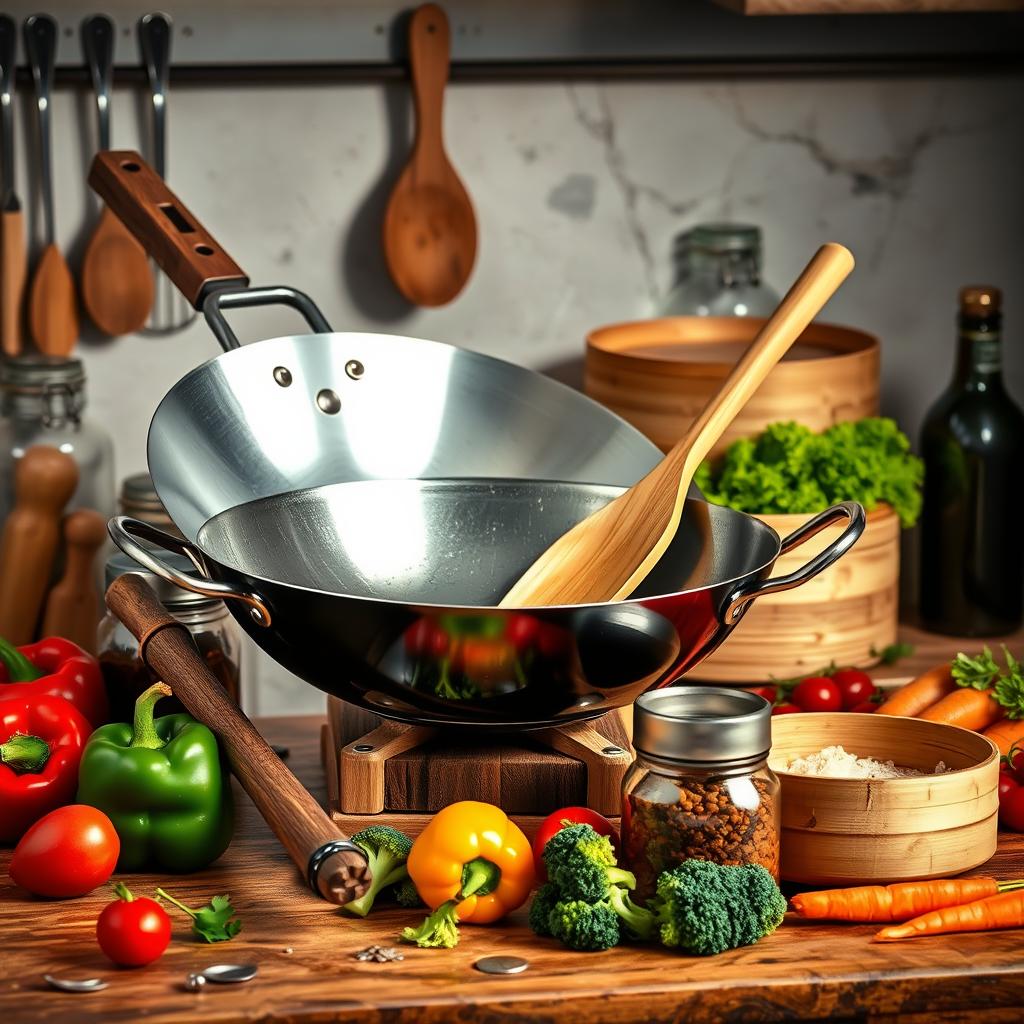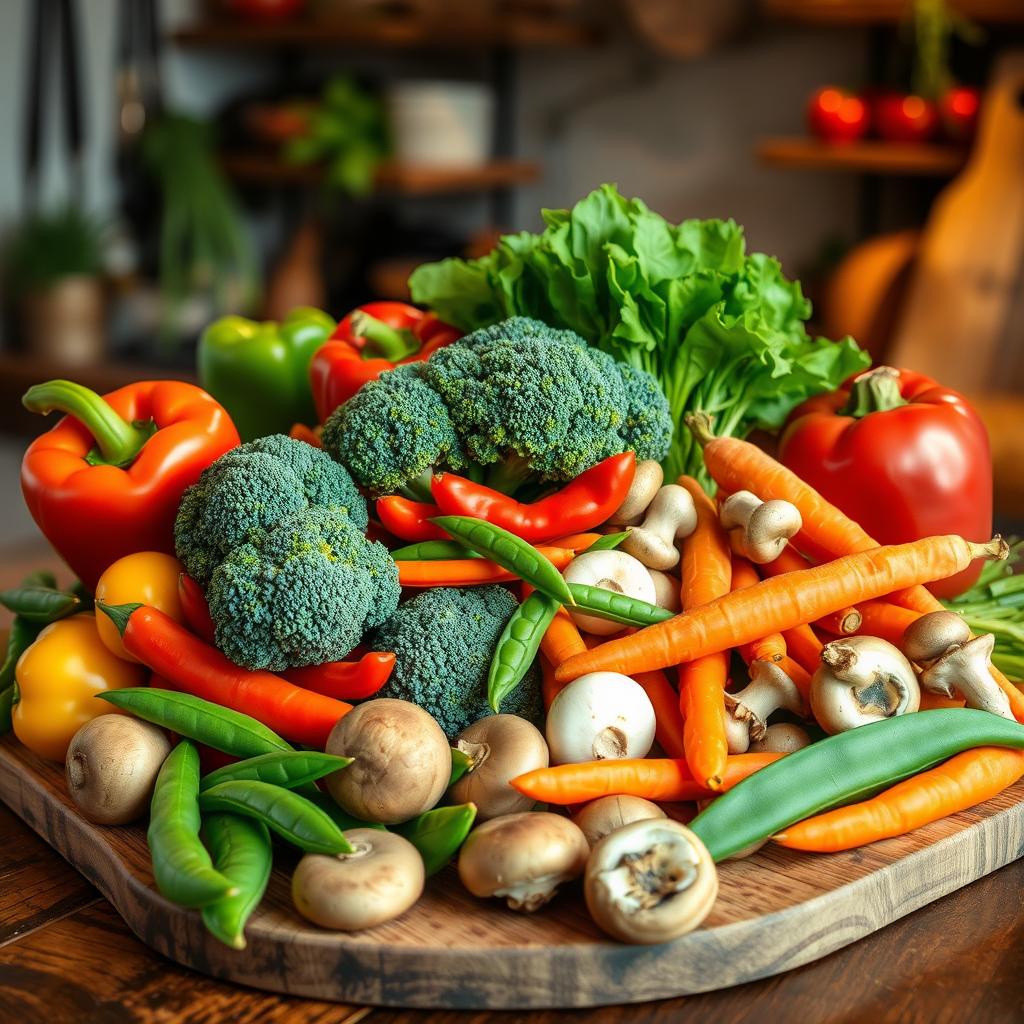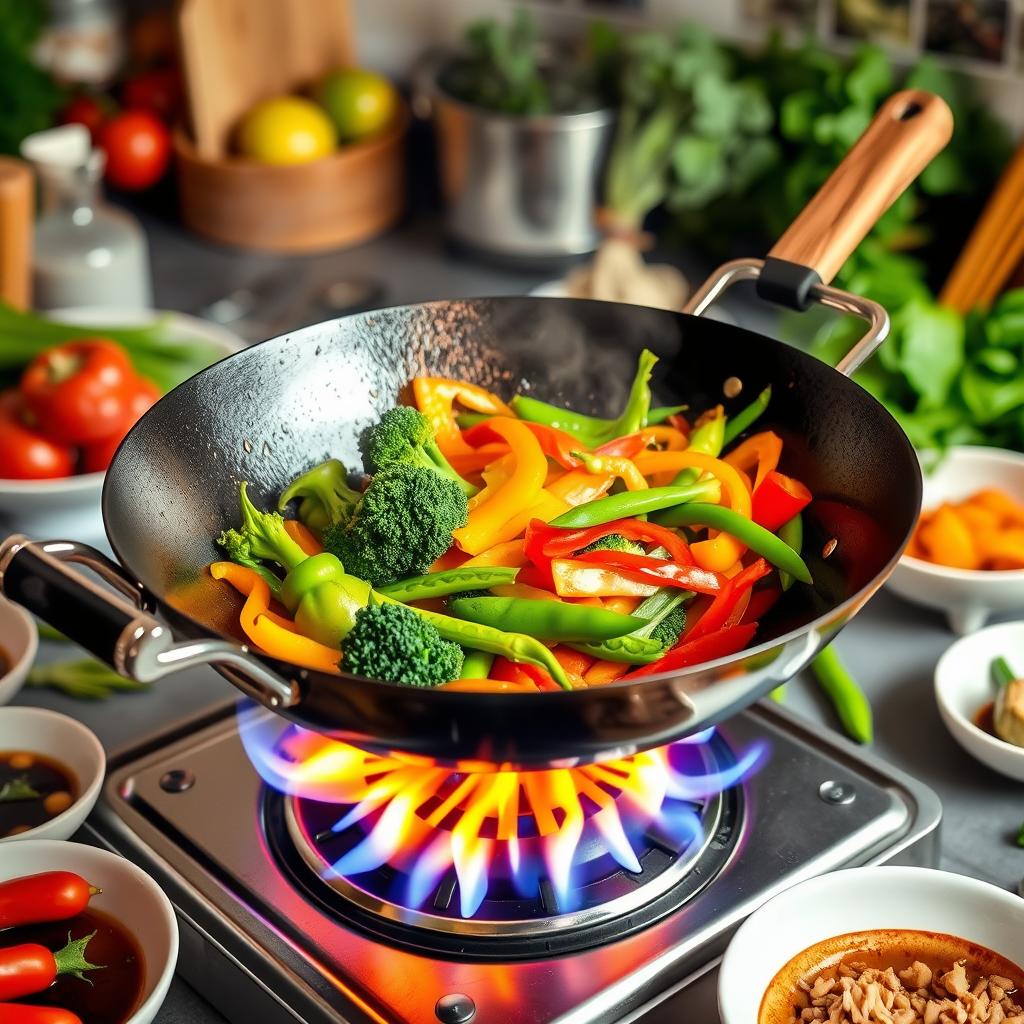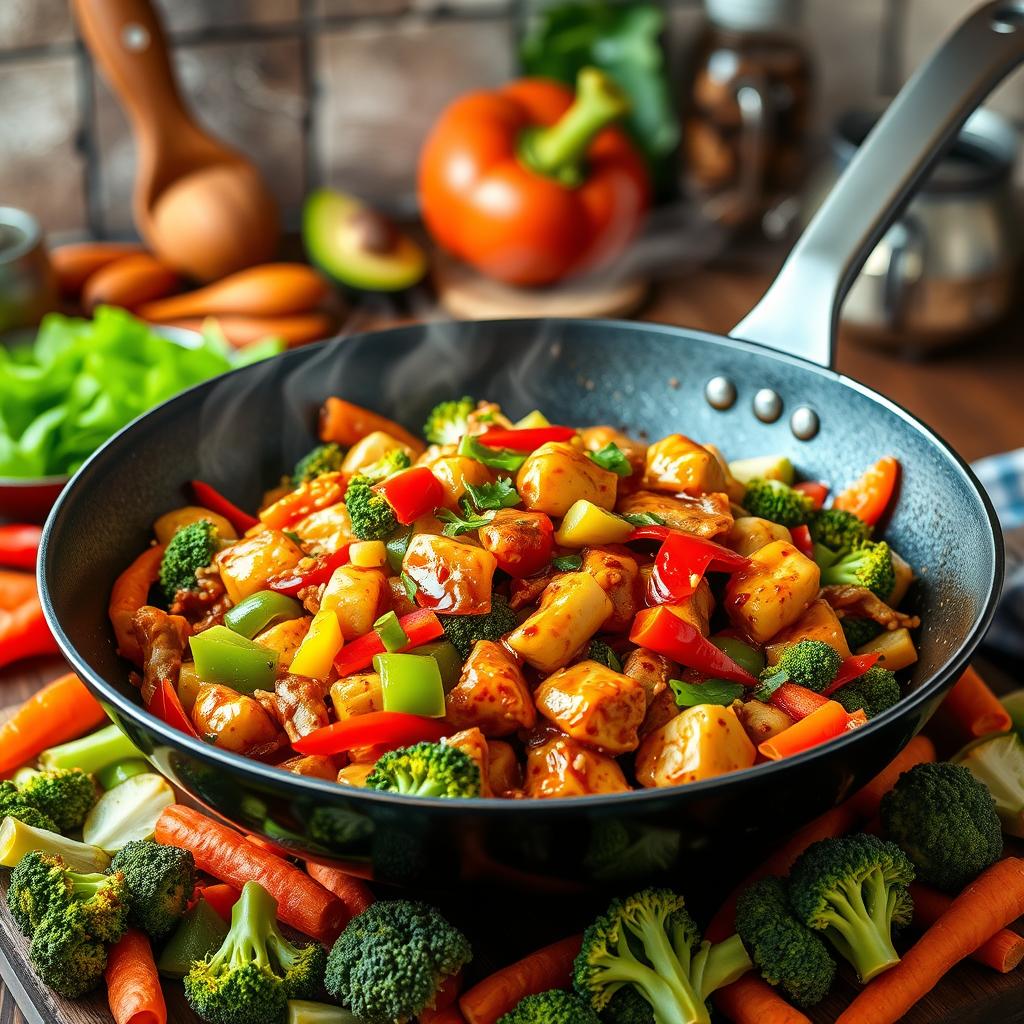Ever craved a tasty meal but dreaded the prep time? Don’t worry, stir-fry cooking is here to save the day. With simple ingredients and a bit of skill, you can whip up top-notch dishes in minutes.
As a busy parent, I know the challenge of juggling work, family, and meals. Stir-fry Recipes has become my quick fix for healthy, tasty meals. This guide will teach you to master the art of stir-fry, making dishes your family will love.
Let’s dive into stir-fry’s rich history and techniques. You’ll learn how to pick the best proteins and veggies and make a delicious sauce. Soon, you’ll be a stir-fry pro, impressing everyone with your quick and tasty meals.
Table of Contents
What is Stir-Fry Cooking?
Stir-frying is a cooking method from China. It involves quickly cooking ingredients in a wok or large skillet. This method requires constant tossing and stirring to ensure even cooking and to keep flavors locked in. Wok Cooking and Asian Cuisine are key to stir-fry, combining proteins, vegetables, aromatics, and sauces.
A Brief History of Stir-Frying
Stir-frying started in ancient China as a quick and practical way to cook. Over time, chefs have honed this method. Notably, Cantonese cuisine experts have made significant contributions, even winning James Beard Awards for their work.
Key Ingredients in Stir-Fry
- Proteins: Chicken, beef, pork, shrimp, tofu, and more are used in stir-fries.
- Vegetables: Broccoli, bell peppers, carrots, onions, and mushrooms are common.
- Aromatics: Garlic, ginger, and other ingredients add flavor.
- Sauces: Soy sauce, rice vinegar, and sesame oil are used for flavor.
These ingredients, combined with quick cooking, make stir-fries a tasty and healthy meal. They are a big part of Asian Cuisine and Wok Cooking.
“Stir-frying is not just a cooking technique, it’s an art form that has been perfected over centuries in Asian cultures.”
Essential Tools for Stir-Frying
Mastering Wok Cooking and making tasty One-Pot Meals needs the right tools. From the basic wok to special utensils, the right gear makes a big difference. Let’s look at the key tools that will improve your stir-fry skills.
Must-Have Utensils
- Wok or large skillet: A good wok or skillet is key for stir-frying. It needs to distribute heat well for high heat cooking. Look for materials like silicone, nylon, wood, stainless steel, and carbon steel.
- Wooden or metal spatulas: These tools help you move and toss ingredients easily. This ensures even cooking. The handle should fit your wok for better control.
- Sharp knives: Sharp knives are vital for quick prep work. They make stir-frying faster and more efficient.
- Squeeze bottle: A squeeze bottle makes it easy to add sauces and oils while stir-frying.
- Spider or strainer: A perforated spider or strainer helps lift and drain small food portions from the wok.
Recommended Cookware
Good cookware can also enhance your stir-frying. Here are some recommendations:
- Bamboo steamer: A bamboo steamer lets you steam ingredients with your stir-fry. It makes for a complete meal.
- Metal steaming rack: A metal rack inside your wok allows for steaming and stir-frying at the same time.
- Wok lid: A good lid traps heat and moisture. This ensures your food cooks evenly.
- Hot dish tongs: Strong tongs help handle hot dishes. They make tossing and serving your stir-fry easy.
- Wooden chopsticks: Wooden chopsticks are traditional and practical for mixing ingredients in the wok.
- Prep bowls: Small, deep prep bowls help organize and add ingredients smoothly to the wok.
Getting the right tools and cookware for Wok Cooking and One-Pot Meals can greatly improve your stir-fry experience. You’ll get perfectly cooked, tasty dishes every time.

Choosing the Right Proteins
When making a Protein Stir-Fry, picking the right proteins is key. You can choose from chicken to lean beef. Let’s look at some popular proteins and how to marinate them for better taste and texture.
Popular Proteins for Stir-Fry
- Chicken breast: It has 31 grams of protein per 3-ounce serving. Chicken is also rich in selenium, phosphorus, and B vitamins.
- Beef strips: With 21.3 grams of protein per 3-ounce serving, lean beef is a hearty choice.
- Tofu: A plant-based option, tofu has about 8 grams of protein per half-cup. It’s great for vegetarians and vegans.
- Shrimp: Shrimp packs 20.3 grams of protein per 3-ounce serving. It’s flavorful and versatile in stir-fries.
- Eggs: One large egg has 6.3 grams of protein. Eggs are also a good source of iron, B vitamins, and more.
- Legumes: Beans and lentils have 7-8 grams of protein per half-cup. They add nutrition and fillingness to your stir-fry.
Tips for Marinating Proteins
Marinating proteins can make your Protein Stir-Fry taste better and be more tender. For chicken, try a marinade of soy sauce, garlic, ginger, and oil. Marinate for 15-30 minutes to add flavor without making the meat too soft.
For beef or tofu, a marinade of soy sauce, rice vinegar, and spices can enhance the taste. Try different marinades to find your favorite flavors.
The Importance of Vegetables
Vegetables are the heart of a great Vegetable Stir-Fry or Healthy Stir-Fry. They bring essential nutrients, vibrant colors, and tasty flavors. Learning to pick and prepare the right veggies is crucial for a memorable stir-fry.
Best Vegetables for Stir-Frying
Some veggies are perfect for Vegetable Stir-Fry. These include:
- Bell peppers (sliced thinly)
- Broccoli (cut into small florets)
- Carrots (julienned)
- Snap peas (trimmed and halved)
- Mushrooms (sliced)
These veggies cook well under stir-fry heat. They add color and flavor to your dish.
Cutting and Prepping Veggies for Stir-Fry
Good cutting skills are key for a successful Vegetable Stir-Fry. Slice bell peppers thinly for even cooking. Cut broccoli into small florets and julienne carrots for more surface area. Preparing veggies ahead saves time and lets you focus on stir-frying.
| Vegetable | Cutting Technique |
|---|---|
| Bell Peppers | Sliced thinly |
| Broccoli | Cut into small florets |
| Carrots | Julienned |
| Snap Peas | Trimmed and halved |
| Mushrooms | Sliced |
Choosing the best veggies and mastering cutting and prep can elevate your Vegetable Stir-Fry. You’ll create a Healthy Stir-Fry that’s both delicious and satisfying.

Understanding Stir-Fry Sauces
Stir-fry sauces are essential for any Asian-inspired dish. They’re perfect for quick weeknight meals or new flavor experiments. We’ll look at common sauce bases and how to make your own signature sauce.
Common Sauce Bases
The most common sauce bases for stir-fries include:
- Soy sauce: This umami-rich condiment forms the foundation of many stir-fry sauces.
- Oyster sauce: Made from oyster extracts, this sauce adds a savory, slightly sweet flavor.
- Hoisin sauce: A sweet and spicy sauce that lends depth to stir-fries.
How to Create Your Own Sauce
To make your own stir-fry sauce, start with soy sauce, rice vinegar, and honey or brown sugar. Add cornstarch to thicken it. You can also add sesame oil, chili paste, or citrus juice for extra flavor. The world of Stir-Fry Sauces and Asian Cuisine is full of possibilities.
| Ingredient | Quantity |
|---|---|
| Soy sauce | 1/2 cup |
| Chicken broth | 1/3 cup |
| Sesame oil | 1 tsp |
| Rice vinegar | 2 tsp |
| Worcestershire sauce | 1 tsp |
| Minced garlic | 3 cloves |
| Minced ginger | 1 tsp |
| Brown sugar | 2 tbsp |
| Red pepper flakes | 1/2 tsp |
This versatile Stir-Fry Sauce can be stored in an airtight container in the refrigerator for up to a week. It’s a great addition to your Asian Cuisine collection.
“The secret to a great stir-fry is in the sauce – it’s what brings all the flavors together.”
Cooking Techniques and Tips
Mastering stir-fry cooking is about the right heat and timing. Wok Cooking makes quick, flavorful Quick Meals with great textures.
The Right Heat Level
High heat is key for a good stir-fry. It sears your ingredients and keeps veggies crisp. Cook proteins first, then set them aside for veggies.
Stir-Frying Steps to Remember
- Cook proteins first, then set them aside.
- Stir-fry veggies next, keeping them crisp.
- Put everything back in the wok with sauce. Stir-fry until all is heated and coated.
Timing is Key
Timing is crucial in Wok Cooking. Cook ingredients from longest to shortest cooking time. Start with hard veggies like carrots, then softer ones like mushrooms.
“Mastering the art of stir-fry cooking is all about finding the perfect balance of heat, timing, and technique.”

Follow these tips for Quick Meals full of flavor and texture. Stay focused and quick, letting your wok do the work.
Quick and Easy Stir-Fry Recipes
Craving a delicious meal but short on time? These stir-fry recipes are perfect. Stir-frying is fast and efficient. It lets you make tasty dishes in minutes, ideal for easy weeknight dinners.
15-Minute Chicken Stir-Fry
This 15-minute chicken stir-fry is a weeknight winner. It has tender chicken, crunchy veggies, and a savory sauce. It’s ready in 15 minutes.
Marinate the chicken in soy sauce and cornstarch. Then, stir-fry with bell peppers, snap peas, and a homemade sauce. It’s a nutritious meal with 38g of protein and 547 calories per serving.
Beef and Broccoli in Under 20 Minutes
Need dinner fast? Try our beef and broccoli stir-fry. Thinly sliced beef and broccoli florets cook in a savory sauce. It’s a balanced meal in under 20 minutes.
It has 523 calories, 26g of protein, and 25g of carbs per serving. Serve it over rice or noodles for a complete meal.
“My family devours this chicken stir-fry every time I make it. The kids even eat more veggies when I serve this dish!” – Sarah, Herndon, VA
Nutritional Benefits of Stir-Frying
Learning to make a Healthy Stir-Fry is all about the benefits. Stir-frying is a great way to cook because it keeps more nutrients in veggies. It also uses less oil, which is good for Quick Meals.
Healthier Cooking Methods
Stir-frying uses high heat to make food taste better without extra sauces. It’s easy to add veggies, lean proteins, and whole grains. This makes meals balanced and full of nutrients.
Balancing Nutrients in Your Meal
A good stir-fry has many colors, meaning lots of nutrients. The quick cooking keeps vitamins and minerals in the veggies. This way, you get the most from your food.
“Stir-frying dates back over 2,000 years to the Han Dynasty in China, and it’s a cooking method that has stood the test of time for a reason. The high heat and rapid cooking help to lock in flavor and nutrients, making it a go-to choice for busy home cooks.”
Stir-frying is also very flexible. You can add lean proteins like chicken or tofu, along with veggies and grains. This makes a meal that’s good for you and tastes great.
By getting good at making Healthy Stir-Fry, you can have tasty, healthy meals fast. It’s perfect for quick weeknight dinners or when you want a Quick Meal.
Customizing Your Stir-Fry
Stir-Fry Recipes are incredibly versatile. You can change them to fit your taste and dietary needs. Try new spices, herbs, and aromatics to make your dishes more complex.
Adding Bold Flavors
Stir-fry dishes are great for bold flavors. Add chili flakes or lemongrass paste for heat and smell. Use spices like five-spice powder or garam masala for extra flavor. Be creative with your seasonings and marinades.
Dietary Modifications
Stir-frying works for many diets. For a veggie or vegan option, use tofu or tempeh. Choose gluten-free soy sauce like tamari or coconut aminos. Serve it with cauliflower rice or zucchini noodles to cut carbs.
| Ingredient | Quantity | Purpose |
|---|---|---|
| Chili Flakes | 1 tsp | Add heat and spice |
| Lemongrass Paste | 1 tbsp | Enhance aroma and flavor |
| Five-Spice Powder | 1/2 tsp | Provide complex spice blend |
| Tamari | 1/4 cup | Gluten-free soy sauce alternative |
| Cauliflower Rice | 2 cups | Low-carb stir-fry base |
By trying new flavors and dietary options, you can make stir-fries that are just right for you. The world of Asian Cuisine is full of possibilities for personalization.
Stir-Fry as a Meal Prep Solution
Stir-fry is great for quick weeknight meals. A bit of prep work lets you enjoy homemade meals all week.
Making Stir-Fry Ahead of Time
Efficient stir-fry prep starts with chopping ingredients early. Slice proteins, chop veggies, and make sauce ahead. This makes quick stir-fry assembly possible.
Storage Tips for Meal Prepping
- Let cooked stir-fry cool before portioning.
- Portion into containers for 3-4 days in fridge or freeze longer.
- Reheat with water to avoid drying. Add fresh garnishes for flavor.
Prepping stir-fry ingredients saves time for quick, nutritious meals. Even on busy nights, you can enjoy a great stir-fry.

“Stir-fry is the ultimate weeknight hero – it’s quick, versatile, and endlessly customizable. Meal prepping the components makes it even easier to enjoy a healthy and satisfying stir-fry anytime.”
Stir-Fry Around the World
The art of stir-frying has spread far beyond China. Now, cooks around the world use this versatile method. In Thailand, stir-fries are filled with fish sauce and basil. In Korea, they’re spicy with gochujang.
This shows how Asian cuisine is rich and diverse. Each culture adds its own twist to stir-fries.
Popular Stir-Fry Styles from Different Cultures
In Japan, stir-fries often include miso for a deep flavor. They might also use sake for sweetness. Southeast Asia adds a zesty touch with lemongrass.
Western versions bring their own flair. They use bell peppers and spices to make stir-fries unique.
Notable Regional Ingredients
The love for Asian Cuisine and Stir-Fry Recipes has brought many ingredients together. Bok choy is a staple in China, while bell peppers add color worldwide. Each place adds its own flavor to stir-fries.
This mix of cultures has created many stir-fry styles. Each one has its own special taste and smell.

